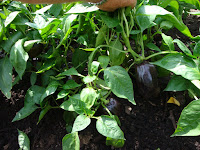

Delicious recipes including green peppers are a must if your garden is like ours this time of year. The green peppers are really producing. It's almost as if they know that the first frost will be here soon, so they are going to dazzle us before they die.
Peppers are relatively easy to grow, so if you are a beginning gardener, try green peppers. California Wonder is a good old stand-by. Don't stick to just green peppers either. There are 100's of pepper varieties to choose from. We have planted yellow, chocolate (no, just the color, not the taste of chocolate..LOL) and purple, as well as some of the hot peppers.
If you leave the green peppers on the plant, they will begin to turn red. These are sweeter and have a different texture. Salads and salsa are so pretty with the green and red mixed peppers.
Recipe--Stuffed Green Peppers
We like the peppers stuffed with or without the meat using corn or peas or more veggies from the garden.
Place 6 peppers (either a full-sized pepper with the tops off and seeds cleaned out or a cleaned pepper cut in half) in a micro-waveable 8" x 8 " dish. (Yes,this is so much easier than boiling them for 5 minutes in boiling water, I think.) Salt the inside of the peppers. Cook the peppers in the microwave for 3-4 minutes depending on how thick the wall is. They need to be hot.
Prepare a cup of rice--instant, brown, whatever your family prefers.
Brown one pound of ground beef with onions in a large skillet. Drain. Return to the skillet.
Add rice and 3/4 can of diced tomatoes with onion and green peppers including juice. You may add salt and garlic to taste. Heat through.
Stuff peppers with meat mixture. Top with remaining tomatoes and juice. Return to microwave and cook covered 10-12 minutes or bake in 350 degree oven, covered, for 45 minutes. Remove foil from oven baked peppers, and cook 10-15 minutes longer.
Remove from heat and sprinkle tops with cheese. No need to return the peppers to the heat as the cheese will melt.
I let the dish of peppers set for five minutes before serving. Enjoy!
 I know an art competition has nothing to do with veggie gardening, but we all need some relaxing time. The Artprize 2009 in Grand Rapids, Michigan is definitely an escape. Gorgeous art work in all kinds of creative medium is on display for the public to choose the winner of the $250,000 prize. The event is through Oct. 7. Go if you are in the West Michigan area.
I know an art competition has nothing to do with veggie gardening, but we all need some relaxing time. The Artprize 2009 in Grand Rapids, Michigan is definitely an escape. Gorgeous art work in all kinds of creative medium is on display for the public to choose the winner of the $250,000 prize. The event is through Oct. 7. Go if you are in the West Michigan area.





